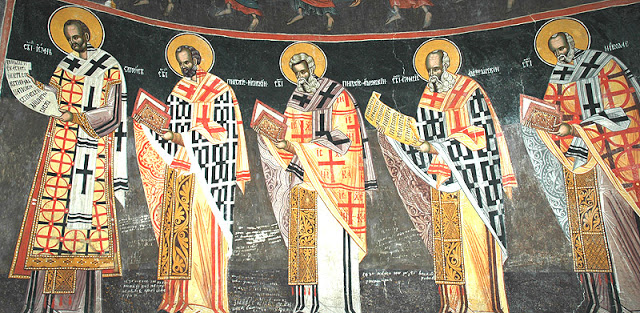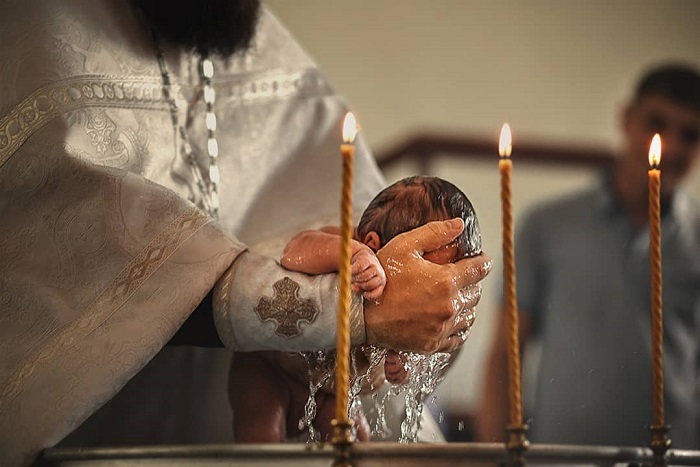
We Orthodox Christian hear this question quite often. In fact, it strikes a much deeper issue, namely, the issue with the Holy Tradition, which incorporates the works by the Holy Fathers. Here is a 101 on the Holy Tradition and why, according to the Church, you can’t understand the Bible without it.
Is the Bible Enough?
The correlation between the Holy Scripture and the Holy Tradition has been hotly contested between the Orthodox and the Protestants for centuries. It was as early as the 16th century that Protestants proclaimed their famous doctrine of Sola Scriptura (Latin for “only the Scripture”), claiming that the text of the Bible is enough for proper Christian living. They declared that the Bible contains just enough information for our salvation and that the Tradition was a later and useless invention, which Christians had to get rid of as quickly as possible.
Orthodox theologians radically oppose this approach. The Church teaches that the Holy Tradition is the earliest way of transmission of the Divine Revelation.
The Holy Tradition existed before the Holy Scripture and served as its basis. It isn’t hard to grasp it: even during our everyday lives we experience something first and then express our experiences in written form, if necessary. Aside from that, even the Bible admits that the Holy Tradition comes first.
Thus, we learn from the book of Genesis that God talked with Adam, Abraham, Isaac, Jacob, and Moses directly. We see that Abel already knows how to make a sacrifice of the firstlings of his flock and of the fat thereof to God (Gen. 4:4). Noah knows which animals are “clean” and which are “unclean” (Gen. 7:8). Abraham knows the tradition of tithing when he gives tithes to Melchizedek, king of Salem (Gen. 14:20). It is worth pointing out that none of them read the Scripture because there weren’t any written Scriptures at those times.
Old Testament characters lived without the sacred texts of the Scripture for many centuries. Likewise, early Christians did without the written New Testament because they tuned their spiritual and everyday lives in accordance with the oral Tradition of the Church.
Therefore, the Scripture is essentially the recorded part of the Tradition, which is why the former cannot exist without the latter.
Furthermore, the very fact that the Divine Revelation had to be put to paper, according to Saint John Chrysostom, indicated a steady decline of morals and spiritual deafness, which was spreading among people:
“In fact, we shouldn’t need the Scriptures; instead, we should lead a life so pure that we could use the grace of the Holy Spirit instead of books; and to the extent that books are written with ink, our hearts should be written on by the Spirit. Given that we have rejected that grace, let’s at least use the second way [i.e., the written Scripture—Translator’s Note].

“Blank Spots” in the Holy Scripture
Interestingly enough, if we “remove” the Holy Tradition from the Divine Revelation, there will appear “blank spots” in the biblical text immediately—and it’s impossible to fill in those gaps without additional sources.
For example, Jacob tells his son Joseph in Genesis: “Moreover I have given to thee one portion above thy brethren, which I took out of the hand of the Amorite with my sword and with my bow.” (Gen. 48:22). However, nowhere in the Scripture (in the book of Genesis) do we find any mention of military actions that Jacob undertook against the Amorite with his “sword” and his “bow”.
Apostle Paul matter-of-factly writes to Timothy, “Now as Jannes and Jambres withstood Moses, so do these also resist the truth: men of corrupt minds, reprobate concerning the faith.” (2 Tim. 3:8) Again, here is the question: Where did Paul read about it if there isn’t any mention of a Jannes and a Jambres and their conflict with Moses in the Bible?
Archdeacon Stephen informs the Jews, “And Moses was learned in all the wisdom of the Egyptians, and was mighty in words and in deeds. And when he was full forty years old, it came into his heart to visit his brethren the children of Israel.” (Acts 7:22-23) And again, There is no mention of Moses’ age when it came into his heart to visit his brethren. There are plenty of similar examples in the Bible.
Moreover, there is a more fundamental problem, too. Readers of the New Testament must have faced it when they read the entire biblical corpus but could not find a detailed doctrine regarding certain basic tenets of Christianity, such as Sacraments. The question is: Why is the Bible silent about all those matters? This question can’t be resolved within the Sola Scriptura mindset.
Besides, the structure of the New Testament without the Holy Tradition appears vague due to discrepancies and incomprehensible passages. For example, what does Jesus Christ has in mind when He refers to the Heavenly Bread, to the grapevine, and to the water that flows into the eternal life? What does Apostle Paul urge us to do when he says, “[L]et a man examine himself, and so let him eat of that bread, and drink of that cup. For he that eateth and drinketh unworthily, eateth and drinketh damnation to himself, not discerning the Lord’s body” (1 Cor. 11:28-29)? What do the grapevine, the water, the bread, and the cup refer to? The New Testament text doesn’t provide us with a clear explanation.
However, all those questions disappear as soon as we put the Scripture into its original context, i.e., the Tradition.
Archpriest John Meyendorff stresses that the aforementioned words of Jesus “cannot be fully appreciated without knowing that Christians of the 1st century performed baptisms and celebrated the Eucharist.” Sayings about the cup, the grapevine, and the bread become clear as soon as we put them in the context of the Tradition. Again, it shows that the Scripture and the Tradition are reciprocally connected and inseparable. Their unity is the prerequisite for the conceptual completeness of the Divine Revelation.
The Holy Tradition is the prerequisite for true understanding of the Scripture, the point of reference based on centuries-long reading and analysis of the Bible, which allows every Christian to read God’s Revelation without the risk of distorting its meaning.
Remember the story from the book of Acts where Apostle Philip asked the Eunuch who was reading the Old Testament, “Understandest thou what thou readest?” The eunuch replied, “How can I, except some man should guide me?” (cf. Acts 8:30-31)? It is the Holy Tradition that “guides” a believer. It instructs us not only how to read the Scripture but also how to get saved.

There’s Neither Tradition Nor Scripture Without The Church
Both the Holy Tradition and the Holy Scripture exist only for the Church and only within the Church. There is neither the Holy Scripture nor the Holy Tradition outside of the Church.
Hieromartyr Hilarion (Troitsky) emphasizes that the Holy Scripture is part of the general grace-filled life of the Church. There is no Scripture, in the real sense of this word, without the Church.
Alexei Khomyakov pointed out that people who stay away from the Church are unable to comprehend the Scripture, the Tradition, and the practice of the Church.
At first, these statements might appear too straightforward and alienating. Yet, if we put them in the right context, all misunderstandings will be resolved.
Let’s imagine that I want you to discover Stravinsky’s music. I know a lot about his works; I can even give you a lecture on them, and then equip you with several good scholarly papers for additional reading. You will listen to my words, read the papers, and learn the facts, but you won’t discover Stravinsky’s music for yourself. The most important factor is missing: your personal encounter with his music, full immersion, and direct interaction with live performance of Stravinsky’s music.
Same with the Scripture and the Tradition. You can speak about them for as long as you wish and read hundreds and thousands of scientific papers about the Scriptures and the Tradition. Sadly, without a personal encounter and the unmediated experience of building your own life on the Scripture and the Tradition, they will merely remain curious artifacts of human history.
You can encounter them and discover them only in the Church, which lives and breathes the Scripture and the Tradition for several millennia already. The Church has an uninterrupted succession of those who dedicate themselves to preserving the Scripture and the Tradition, i.e., the saints.
Holiness means that a certain person lives according to the Tradition and the Scripture, that the fullness of Divine Revelation is fully embodied in the lives of certain people but first of all in the life of Jesus Christ. Stravinsky’s music is revealed to us only if we listen to it live; similarly, the Tradition and the Scripture are fully revealed to us only if we are in the Church, if we participate in Her holiness. The most profound experience of the Tradition is possible only through the Sacrament of Eucharist. The Eucharist is the crossroads where the Tradition and the Scripture meet.
The fullness of the Divine Revelation was given to the Church only once, on the Day of Pentecost. The Christians of the subsequent centuries merely unveiled and gradually explained this diverse Tradition.
Decrees of the Ecumenical Councils, doctrines of the Church, works by Holy Fathers, iconographic canon, church architecture, and the biblical canon—all of those are parts of the Holy Tradition.
Therefore, Church doctrine doesn’t evolve or develop in any way. It is expressed in the history of the human race and in the lives of holy people.
Saint Augustine who discovered the Tradition and the Scripture only after he met Saint Ambrose of Milan, wrote the following paradoxical words: “I wouldn’t believe the Gospel if not for the authority of the Orthodox Catholic Church.” We can rephrase the saint’s words and declare, “I wouldn’t believe the Tradition if not for the authority of the Orthodox Catholic Church.”
The authority in the Church is the Holy Spirit who dwells in it.
Translated by The Catalog of Good Deeds




